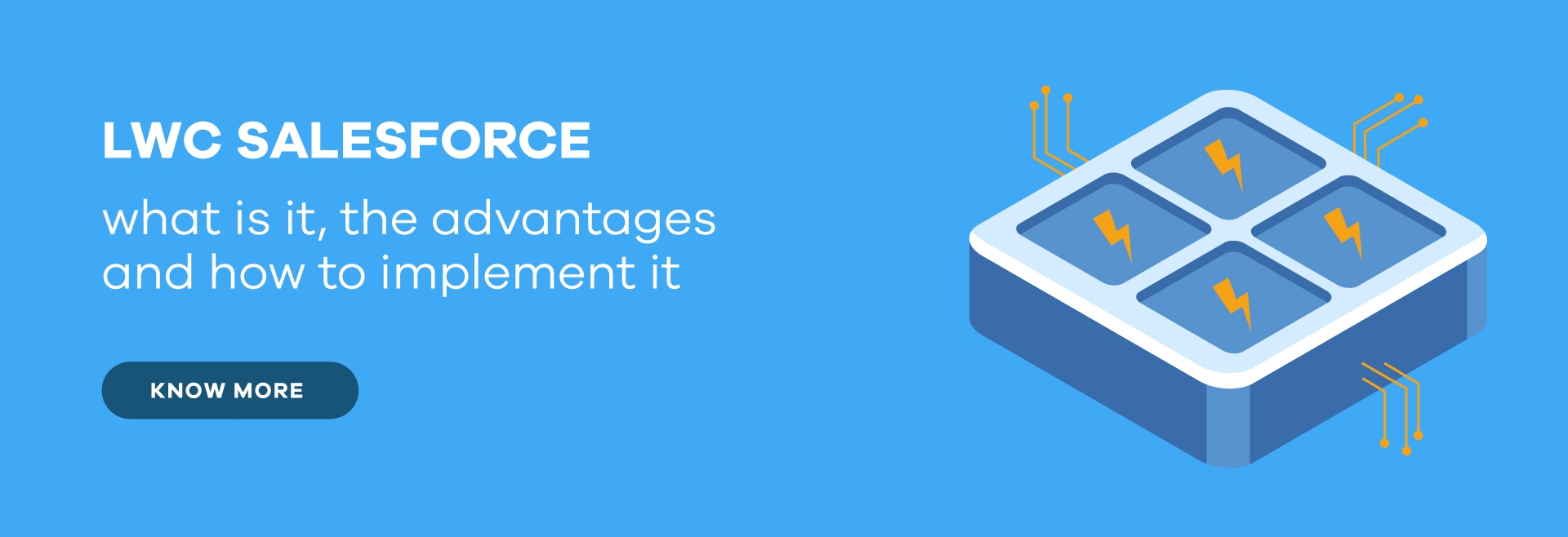
LWC Salesforce: what is it, advantages and how to implement
LWC Salesforce is the fastest way to build web apps with less coding and tighter security.
This is what that means, what the benefits are, and how to implement it.
Easier to build, adapt and roll-out. Welcome to Lightning Web Components (LWC), an addition to the Salesforce Framework. LWC Salesforce requires fewer coding skills to create web apps’ interfaces, significantly cuts development lead-time and relies on universal tools and web standards. This is what you need to know about the programming model, its advantages and how to get started right away:
- LWC Salesforce: what is it?
- LWC Salesforce: what are the advantages?
- LWC Salesforce: how to implement?
- Looking for a LWC Salesforce Partner?
LWC Salesforce: what is it?
LWC Salesforce is a new web programming model for developing Lightning components on the Salesforce platform. Lightning Components is a UI framework that is used to create applications for desktop and mobile technologies. Single-page web applications can be built to provide an end-to-end experience on the platform for a variety of functions.
The new Lightning Web Components model is built from standard technology such as CSS, HTML and JavaScript. The goal is to take advantage of custom elements, templates, modules and other language components already available to speed development and save time testing.
Previously, Lightning components were developed using the Aura framework. However, Aura had its own limitations: some key elements were missing, and Aura offered only limited resources for large-scale projects. In other words, the Aura framework did not support developers in creating their own user interface components. In addition, new frameworks, such as Angular or React, were unavailable to Aura users.
In comes LWC Salesforce, which allows the development of components with no need to master the Salesforce platform – and plenty of other advantages.
LWC Salesforce: what are the advantages?
LWC Salesforce have several advantages for developers, customers and even admins. These are the main ones.
Ease of use
Using LWC Salesforce does not require highly specialized human resources to execute and support business needs. Finding programming talent is hard, and wasting it recreating widely available web elements seems foolish. The fact that it allows you to create web applications based on standards makes the whole process more achievable.
Before LWC Salesforce, programmers had to learn the Aura framework, and their prior knowledge did not make the task easier. On the other hand, it is something programmers already understand and master, thus optimizing their acquaintance with the system.
Coexistence of Aura and LWC Salesforce
Although it represents a significant leap forward, it is still possible to integrate Aura components with LWC Salesforce on a single webpage and, in some cases, share data. Thus, the Salesforce platform can rely on these two programming models.
LWC Salesforce uses responsive design, which provides an optimized and fluid user experience. This technology makes it possible to recognize different devices and browsers in order to adapt the applications design accordingly. Programmers can also rely on more advanced features like HTML5 or CSS3.
Increased security
Salesforce provides Lightning Locker, a security architecture for Lightning components. It promotes best practices by isolating components from others belonging to a different namespace. This is a powerful feature in a world where security is an increasingly important topic.
Extra speed
This is the key advantage of LWC. Since the architecture is based on standardization and reuse, components take less time to build. In fact, most LWC components can be implemented by drap-and-drop – of course, further customization requires an expert hand, something we take great pride in here at Near Partner. In addition, LWC is suitable for older browsers that do not yet support all underlying web standards.
Rendering is much faster in LWC compared to the Aura framework, due to API support, which results in superior performance. In addition, as LWC Salesforce is based on standard Web components, its framework is lighter and storage space management is more efficient.
LWC Salesforce: how to implement?
One of the advantages is the ease of implementation. It is not necessary to learn how to use a specific framework – creating simple components is easy. Just like most web apps, JavaScript files hold variables, functions and events. You can even use third-party JavaScript libraries with Lightning web components to reduce code complexity.
HTML files provide the structure for the component and LWC template system uses virtual DOM to render components in an intelligent and efficient way. LWC also uses CSS for design and animation. You can use the Lightning Design System to leverage existing code, which is flexible enough to customize the look and feel according to your brand identity, or you can write your own CSS.
Looking for a LWC Salesforce Partner?
Now that you are familiar with LWC Salesforce, you can consider migrating Aura components to LWC and thus benefit from unprecedented productivity and performance, opening a wider path to your business goals.
If LWC Salesforce fits what you have in mind for your company, just drop us a line. We can help you implement the best practices to deliver Salesforce-powered success. Contact us about our Salesforce services and let us know your business’ needs.





